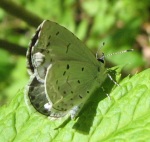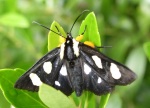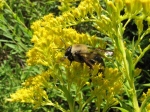Flowers are visited by a great variety of insects, and some spiders too. Some of these insect visitors are very beneficial to the flower. They carry pollen from flower to flower performing pollination. This is what the plant needs to make seeds and thus make new plants and new flowers.
The list of flower visitors is extremely long and some of the insects are impossible to tell apart by sight only, so this guide doesn’t attempt to cover them all. I will just merely highlight some of the most common flower visitors, in particular those that pollinate flowers. You will be able to recognize some of them or, at least, you will know what group they belong to.
What do pollinators look like?
Insects have three body sections, called head, thorax and abdomen. The head carries the eyes, the mouth parts and antennae. The thorax is made of three segments and carries three pairs of legs and generally either two pairs or only one pair of wings. The abdomen is made of a series of segments.
What kind of pollinating insect is that?
Different groups of insects vary on the shape of the head, thorax and abdomen. Of special importance are the variations on the kinds of wings. Future blog entries will cover four main types of flower visitors: 1. bees and wasps, 2. flies, 3. butterflies and moths and 4. beetles.
Bees and wasps have two pairs of membranous wings, they look like saran wrap. The main differences between bees and wasps are that wasps usually have a narrow waist (the separation between the thorax and abdomen) and are less hairy than bees. Female bees usually have a means to carry pollen, the so called pollen baskets or pollen combs, either on their back legs or on the underside of their abdomens. Sometimes these baskets are loaded with pollen.
Ants are related to wasps and resemble them in their appearance, but they have no wings. Only queens and males have wings, but they are seldom seen. Ants are also frequent flower visitors. They rarely can pollinate flowers because they don’t fly and are not likely to carry pollen a significant distance.
Flies are important pollinators too. Their wings are also membranous, like those of bees and wasps but they have only one pair instead of two. The flies that visit flowers often look like bees or wasps. They lack stingers so they are good mimics that try to fool hungry birds into thinking that they can sting. Some of the ways to tell them apart is by the eyes which are very large and by the short antennae, made of two separate parts. They are usually hairless and the legs are very thin when compared to those of bees.
Butterflies and moths have wings covered by very tiny scales. If you touch them some of those scales come off and they look like dust. They have a very long tongue which they use as a drinking straw to sip nectar from flowers. When not in use they keep it rolled up under their chins.
Butterfly’s antennae end in little knobs, while the antennae of moths can either be feathery or like a string, but never with a knob at the end. Butterflies usually fly during the day, while moths fly at night, although a number of them fly during the day. Night flying moths tend to be rather colorless, but those that fly during the day can be as brightly colored as many butterflies.
Beetles have two pairs of wings but the first set is modified and hardened into a wing case that covers and protects the second pair of wings.
You only see this second pair when the beetle is flying or getting ready to fly. This second pair is also membranous like those of bees, wasps and flies and they remain folded under the first pair.
Where can you find pollinators?
Look for pollinators at flowers. The best flowers are native ones. Garden flowers, especially the double ones don’t attract many pollinators, so tulips or fancy roses are not very good for pollinators. Most pollinators are active when it is warm enough, when it isn’t windy and when the sun is shining. There are a few that fly when it is dark and visit night blooming flowers.
Some flowers attract many visitors. Two of the best ones are: common milkweed and all the goldenrods.
Common milkweed blooms in June and early July. The plants can grow 6 feet tall. They have large oval leaves and bunch of flowers arranged like a ball. The flowers are pink and emit a very strong sweet scent.
Goldenrodsbloom in the fall, from September to November, depending on where you live. There are several types of goldenrods; they all have yellow flowers arranged in rods that give the name to the plant. Their scent is not particularly strong but many insects are attracted to it or to the colorful display.
Asters and related flowers attract large numbers of pollinators.
These include many daisy-like flowers such as sunflowers, black-eyed Susans, ragworts, cornflowers, as well as some plants which are not native, dandelions and thistles. The above mentioned goldenrods belong to this family, too.
Mountain mint and Queen Anne’s lace are also good attractants of a variety of flower visitors.
Bees
Honey Bee
Bumble Bees
Carpenter Bees
Halictid Bee or Sweat Bee
Mason Bees and Leaf-cutter Bees
Andrenid Bees
Wasps
Potter Wasps and Mason Wasps
Grass-carrying Wasps
Great Golden Digger Wasp
Hornets and Yellowjackets
Paper Wasps
Flies
Flower Flies or Syrphid Flies
Bee Flies
Blowflies. Lucilia
Butterflies
Monarch
Tiger Swallowtail
Hair Streaks
Pieridae Butterflies: Whites and Sulphurs
Silver Spotted Skipper
Moths
Hummingbird Moth
Hawk Moths
Ailanthus Web-worm Moth
Yellow-collared Scape Moth
Beetles
Tumbling Flower Beetles
Flower Long Horn Beetles
Soldier Beetles
Japanese Beetle
Ladybugs or Lady Beetles
Other frequent flower visitors
Ambush Bug
Crab Spider
——————————————–
Further readings
Overview of Orders of Insects
Native bees of North America
Bumble bees
You may purchase the electronic version:
Beginners Guide to Pollinators and Other Flower Visitors
Tags: bee, bumble bee, butterfly, crab spider, field guide, flower, flower fly, flower visitor, insect, moth, native bee, pollinator












August 22, 2011 at 6:11 pm |
Hello Beatriz Moisset, I am looking at your pollinator photos. Happy Tonics is planning on publishing a pollinator and native plant identification guide of species that visit and nectar at the Monarch Butterfly Habitat in Shell Lake, WI. I very much like the bigger idea that you have of creating a pollinator book in print that can be used as a species identification book. I am going to publish your link on the butterfly page or links page on our Website at http://www.happytonics.org
I believe it is a good learning tool. We will give you copyright credit.
December 4, 2011 at 4:13 pm |
Hello Mary Ellen:
Thanks for your interest. Of course you can place a link on your butterfly page. Thank you very much.
Sorry I missed this post. I can’t believe that it has been so long. I visited your blog and I find it very nice. I have seen you in Facebook also. You may want to contact me by e-mail, bmoisset@aol.com
Good luck with your project.
December 12, 2012 at 9:27 pm |
[…] Beatriz Moisset lives in Southeastern Pennsylvania, studies pollinators and gives presentations at nature centers, garden clubs. Guide to Flower Visitors […]